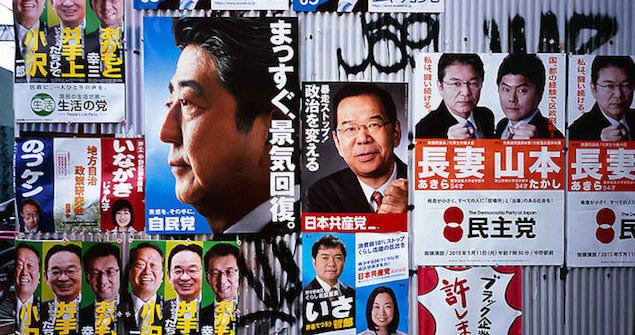Abe’s ‘Mandate’: Implications for Japan's Foreign Policy

Despite the Abe administration’s win in Japan’s lower house election, its victory must be heavily qualified.
The Abe administration’s win in Japan’s lower house election on 14 December suggests essential continuity can be expected from Japan in terms of its international policies. After all, together with coalition partner the Komeito, Abe’s Liberal Democratic Party (LDP) secured the all-important ‘super majority’ of 317 seats in the lower house, allowing them to control committees and over-ride most decisions made by the Upper House if they need to. This seems like business as usual, given that this was the situation before the election. However, when we scrutinise the substance of this electoral victory we see that assumptions concerning continuity are shaky.
The scrutiny should commence with the headline claims that the coalition achieved ‘victory’ and therefore a ‘mandate’. The LDP actually won only 290 seats in the single seat constituencies in its own right, a net loss of five seats compared to the 2012 campaign. It was the LDP’s coalition partner that increased its vote by four seats. And yes, the other big winner in this campaign was the Japan Communist Party, which increased its vote from 8 to 21, making it able to introduce legislation in its own right. The fact that the JCP was the only opposition party to field enough candidates to technically win the election leaves us in no doubt that this outcome was a protest vote against the LDP.
Moreover when we drill down further into these results, it is clear that the vagaries of the electoral system and the distorting effect of a serious gerrymander mean that the LDP’s win cannot be described as unqualified. Once again, we see that although the LDP won only 48% of the vote in the 295 single seat constituencies in 2014, it ended up with 75% of the seats. In 2012, the LDP won 43% of seats yet walked away with 79% of the available seats. The scale of the victory is therefore artificially distorted. It certainly cannot claim that it represents the will of the people without heavy qualification.
In addition, through the inner workings of the proportional representation system, it was the Komeito that delivered a substantial number of votes to the LDP in this constituency. It is important to note that in the proportional representation constituencies (which are divided into 11 blocs across the nation) voters choose a political party by name, not a candidate. This prompts the question – why were voters leaning towards the Komeito side of the coalition offering? What is the role of the Komeito in the ruling coalition?
Before we turn to that question, we are obliged to acknowledge that the voter turnout of 52% was even lower than the previous record low turnout of 59% in 2012. The largest opposition party, the Democratic Party of Japan, did not even field enough candidates to make a majority win possible.
The epithet of ‘victory’ for the LDP also looks dodgy when we turn to Okinawa. Having lost the govenorship in November, the LDP has now lost all four seats in Okinawa to an anti-base relocation group. This will seriously impede fast-tracking the Futenma US military base relocation to Henoko, and it will add a layer of additional complexity to the revision of the guidelines governing the US-Japan Security Treaty.
All in all, the LDP ‘victory’ must be heavily qualified. It is unrepresentative, it increases the LDP’s reliance on its coalition partner, and the low voter turnout fatally undermines any claim of a ‘mandate’.
The stated aim of Abe’s election call was to renew the mandate for Abenomics in light of Japan’s poor economic performance and a decision to delay the increase in the consumption tax. Most analysts regard this as a fatuous excuse for an early poll, and have pointed to the opportunistic timing of Abe’s election. It maximised the disarray amongst the opposition parties and disrupted the normal electoral cycle to minimise electoral fallout for the government in 2016 (when the next half upper house election would have been called alongside a lower house poll).
The great anomaly is that, while foreign policy was not an electoral issue in the eyes of voters, the major opposition parties tried to make it one. Most voters cared more about the economy, the growing disparity between rich and poor and between urban and rural communities, and the contentious restart of nuclear-generated power. But the fortunes of the Komeito in this election will impact on how the third Abe administration pursues its foreign policies.
Komeito plays the role of ‘check and balancer’ against the LDP. This is particularly noticeable in the foreign policy and defence policy arenas. It was largely because of Komeito opposition that the LDP had to resort to reinterpreting the constitution to allow Japan the right of collective self-defence. The pacifist Komeito simply could not live with constitutional revision of Article 9, and their Soka Gakkai backers would not let them.
The Komeito is effectively performing the role of opposition to the LDP in the controlled adversarial context of the coalition.
The LDP needs the Komeito to exercise its super majority across the board. The Komeito will now become the focus of lobbying: by the US in defence, security and trade; by South Korea and China in territorial disputes; and by interlocutors in ASEAN, which has acquired great strategic weight in Japan’s strategic thinking. But the under-developed nature of the Komeito’s expertise in foreign and security policy is a concern. Can the Komeito lift its vision beyond domestic politics to exercise its quasi-democratic role of balancer?
Australian diplomacy will need to reach out to the Komeito as Abe seeks to elaborate a proactive role for Japan in defence. For while Abe will likely be nominated as Prime Minister when parliament meets on 24 December, it is the Komeito that more accurately represents the popular will in Japan when it comes to foreign and security policy.
Rikki Kersten is Dean of Arts, Murdoch University. This article can be republished with attribution under a Creative Commons Licence.





